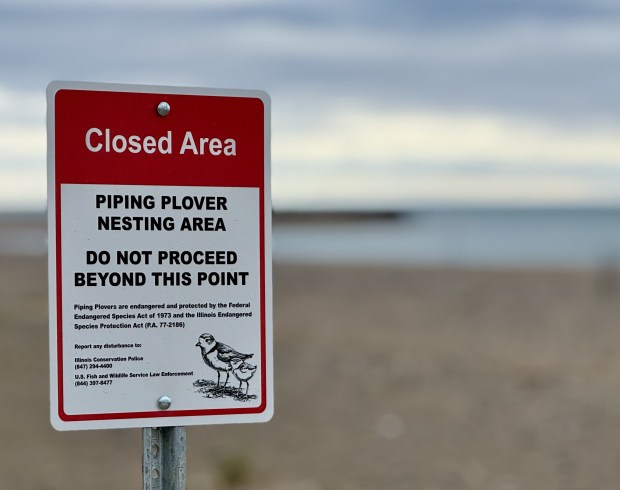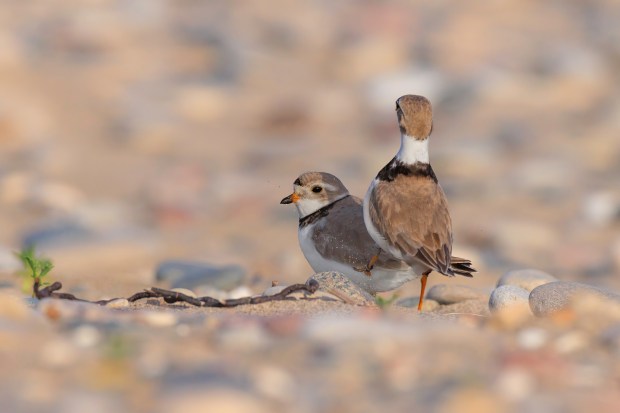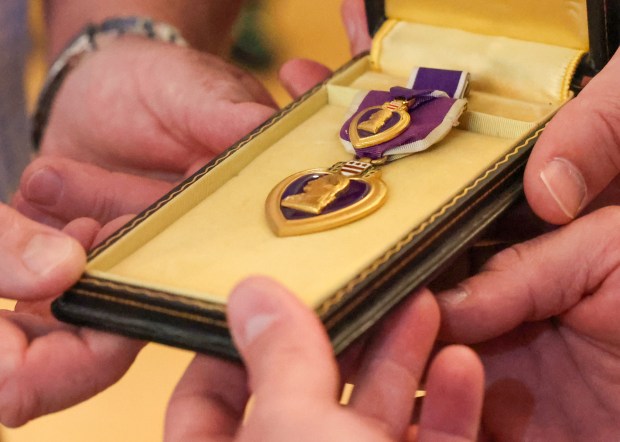Pepper and Blaze — the captive-reared, federally endangered piping plover chicks released on a Lake County beach in 2023 — are back in Waukegan for the second year as breeding adults and the pair is already incubating a full clutch of four eggs.
Last summer, they raised three chicks at the same protected beach at an industrial site in Waukegan.
“I watched them do their nest exchange on May 21,” Lake County Audubon Society President Carolyn Lueck said. “It was beautiful.”
The chicks are expected to hatch around June 17. Monitors will be there watching daily to record observations and keep intruders away.
Brad Semel, an endangered species recovery specialist for the Illinois Department of Natural Resources, has erected a cage around the nest to deter potential predators. He was also out on the beach a few days ago to protect the nest site during a storm.
“We had a scare,” he said. “There were 35-mph winds. We protected the nest. It was about four feet from washing away. It’s drama already.”
Indeed, there’s been plenty of drama regarding the recent nesting of these rare shorebirds, both in Lake County and at Montrose Beach in Cook County. Sea Rocket, who was also hatched in a captive-rearing facility and released at Montrose Beach, nested last summer with Imani. He is the son of Monty and Rose, the famous plover pair that first captured Chicago’s attention in 2019.
Sea Rocket and Imani are back again this year, trying to raise a family at Montrose. Three of their four nestlings from last year died, but one, named Nagamo, survived and could yet return to Montrose to seek a partner. Also wandering the Montrose Beach recently was 2-year-old Pippin, looking for a mate.
Meanwhile, Sage, one of Pepper and Blaze’s offspring, was seen at a beach in Winthrop Harbor, with another first-year plover that hatched on Manitou Island. “He was the offspring of Gabby, the oldest known piping plover who, at 16 years old, is back breeding again this season,” Lueck said.
Lake County monitors observed Sage and her partner courting, but when they weren’t seen for four days, the volunteers were worried. Then Lueck got a text saying Sage and her beau had gone up to North Manitou Island, where they will hopefully breed.
Semel said there’s always a chance they’ll fly back south to Winthrop Harbor in Lake County to attempt to breed there. First-year breeders tend to wander, he said.
The endangered Great Lakes piping plover population is federally protected. Habitat loss due to beach development and other causes reduced the population to 13 pairs in the 1980s, and all of them were in Michigan.
Before then, 500 to 800 pairs of piping plovers had nested in the Great Lakes Region, including in Illinois. “The Waukegan area used to be the primary nesting area for the plovers in Illinois,” Semel said.
Conservation efforts have helped the species rebound to 81 breeding pairs last summer, the highest number since the species was declared endangered, according to the Great Lakes Piping Plover Conservation Team.
The efforts include monitoring summer and wintering locations, banding the plovers and raising some that have lost their parents in captivity before releasing them into the wild. The plovers remain vulnerable to predation, environmental changes and continuing beach development, according to the plover conservation team.

Lueck said Blaze and Pepper’s migration story is epic.
“One of our volunteers texted me at 5:15 a.m. on May 6 saying he had eyes on a banded plover at the north end of Waukegan Beach,” she recalled. “Ten minutes later, he texted he had two plovers.”
Lueck grabbed her car keys and headed out the door, as the monitor texted, “Blaze and Pepper are back.”
Pepper spent the winter in Florida, and Blaze spent the winter 775 miles away in North Carolina. Lueck said she visited Blaze and Pepper over the winter to connect with volunteer monitors who help protect their habitats in the nine months they are not nesting. “That’s a critical part of the story,” she said.
Semel said, “Monitors have put in an incredible amount of hours to be there every day (in Chicago and Waukegan) through the nesting season. Their presence is invaluable.”
Monitors document plover behavior and potential dangers, while educating others about the importance of the Lake Michigan shoreline ecosystem.
The Lake County Audubon Society has partnered with the city of Waukegan to create Sharing Our Shore.
“The goal is to focus attention on these charismatic piping plovers to make sure people understand how valuable it is to protect the habitat,” Lueck said. “By protecting that habitat, you are protecting the habitat for all the other flora and fauna.”
The piping plover has become Waukegan’s official city bird, and the city is celebrating its first-annual Piping Plover Day on May 29. In addition, the story of the piping plover is a permanent exhibit at the new Waukegan History Museum at the Carnegie.
“We are telling the stories of how Lake Michigan has been impacted over the years, and the efforts that have happened or are underway to clean and restore it,” said Ty Rohrer, manager of cultural arts for the Waukegan Park District.
“It is stated in the exhibit that the goal is for the plovers to return each summer to mate and rebuild their population,” he said. “We hope to update this portion of the exhibit to show even more of the successful return of the piping plover to our beaches.”




